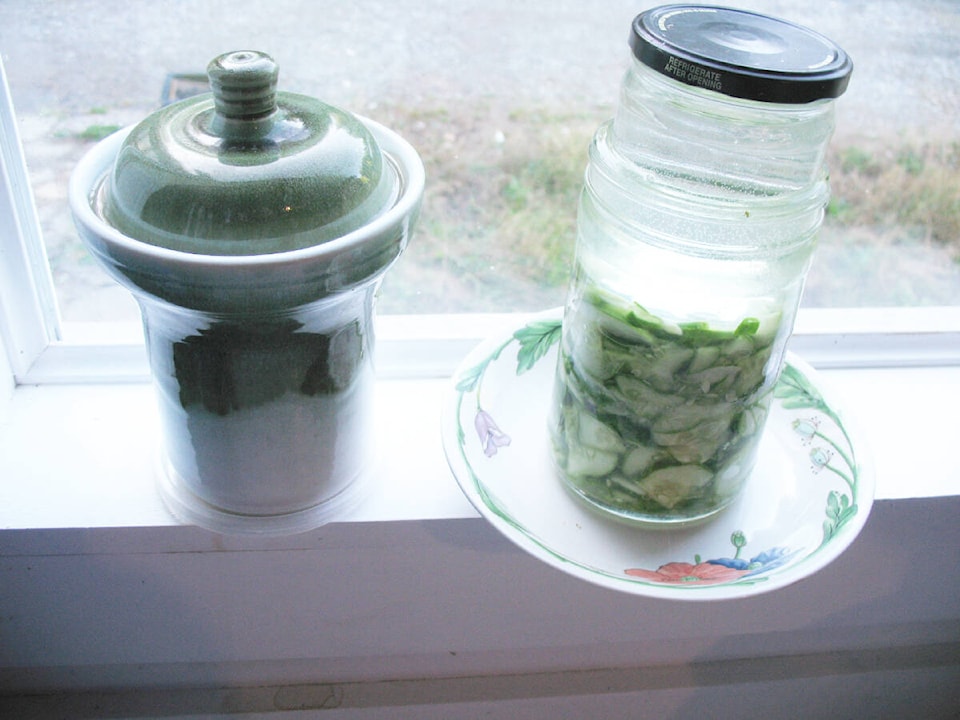By Mary Lowther
The surest sign that this year has produced a bumper crop is that I have exhausted my supply of pint jars for canning. With just the two of us I prefer the smaller jars, but tomatoes and cucumber alone (sauce, salsa, juice, pickles and relish, not to mention beans, beets, peas and peppers) have cleaned me out. With the voices of my Hieland ancestresses echoing in my head I have moved on to my seldom used quart sizes, because “Ye cannae waste gud fud!”
I had a freezer prepared for this anticipated surplus, but David ran into some great deals at the Country Grocer that, like bureaucracy, expanded to fill the space provided. Finding room for vegetables among randomly arranged chicken, beef and bacon was a challenge, although I created a few gaps by bingeing on Haagen-Dazs.
My mom was so organized that it was easy to find anything in her freezer or fridge, and though I aspire to her standards I may not be obsessive enough and my freezer has turned into a maze of unorganized protein. Perhaps my father never went to the grocery store unsupervised. I meant to defrost and organize it in time for the harvest, but when I found the time I discovered the Meat Fairy had been there first! That’s my story and I’m sticking to it.
Faced with buying a second freezer, I decided to find ways to preserve food using less electricity. I have therefore been canning and dehydrating. When I ran out of jars I thought I’d try fermentation as recommended in a great book called Preserving Food Without Freezing or Canning, by the Gardeners and Farmers of Terre Vivante, France. This book is full of traditional recipes that were used before the advent of electricity using salt, oil, sugar, alcohol, vinegar, drying, cold storage and lactic fermentation.
Lactic fermentation sounded like a good place to start because I’ve made sauerkraut and read in Sandor Ellix Katz’s book The Art of Fermentation that fermented vegetables produce lactic acid that kills off pathogens when submerged in liquid such as their own juices. Katz says “people typically rely on bacteria that are present in cabbages and all raw vegetables…lactic acid bacteria and yeasts reliably dominate all raw plant substrates.” My sauerkraut and kimchi turns out tasty, crunchy cabbage, so I don’t see why fermentation wouldn’t work on other vegetables. I found a recipe for fermented sliced cucumbers in the Gardeners and Farmers book and am giving it a try. Contributor Roger Hombeline of Souvigny posted a recipe that only uses salt, and here it is:
Take 2 ½ lbs. cucumbers and 1 ¼ tbsp. salt, peel the cucumbers and nip off the ends. Mix with salt, pack them into jars until the juice runs and keep them submerged with a weight. I have a dandy fermenting jar with weights that keeps the vegetables submerged that I used for half the batch. The other half went into a quart sized peanut butter jar that I topped with a smaller jar filled with water that conveniently fits inside the large jar to keep the vegetables submerged. Roger also mixes the cucumbers with other raw vegetables and uses the brine in sauces, as a substitute for vinegar and as a drink diluted with water. He doesn’t say how long to ferment them so I’ll give it a few days before refrigerating them.
I also came across a terrific recipe on the internet for a variant of V8 juice by Ricky Gilman using 10 vegetables, mostly tomatoes, but this must be canned. Even David likes it so I think I’ll make some more and put it into the quart jars. I’d include that recipe as well, but the timer on my pressure cooker is going off and it’s getting close to my deadline. Maybe next week.
Please contact mary_lowther@yahoo.ca with questions and suggestions since I need all the help I can get.
